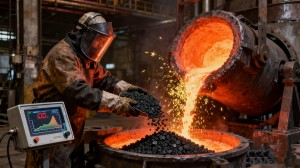Graphitized Carburizer: Application Scenarios
Graphitized carburizer is mainly used in cast iron melting and the production of some special steel grades. Its core function is to supplement carbon elements to the molten metal and improve the morphology of graphite.
1. Cast Iron Industry (Primary Application Scenario)
It is the preferred carburizer in the melting of gray cast iron, ductile iron, and malleable cast iron, for the following reasons:
- Increasing carbon content: It compensates for the carbon loss during the melting process (e.g., excessive addition of scrap steel, coke combustion) and adjusts the carbon content of molten iron to the target range (usually 2.5%-4.0%).
- Optimizing graphite morphology: With its complete graphite crystal structure, it can act as “graphite nuclei” to promote the precipitation of graphite in molten iron, reduce the chill tendency, make cast iron parts easier to machine, and improve mechanical properties (e.g., the compressive strength of gray cast iron, the toughness of ductile iron).
- Reducing the impact of harmful elements: Compared with non-graphitized carburizers (such as coke and coal-based carburizers), it has extremely low sulfur and nitrogen contents, which can prevent defects like pores and cracks in cast iron parts.
2. Production of Special Steels and Alloys
It is used in small quantities in some steel grades that have high requirements for carbon content and purity:
- Alloy structural steel/tool steel: When precise control of carbon content is required (e.g., supplementing carbon in low-carbon steel to reach the medium-carbon range), it is used to add carbon, avoiding the introduction of impurities such as sulfur and phosphorus that affect the hardenability and hardness of steel.
- Stainless steel/high-temperature alloy: In the melting of certain carbon-containing stainless steels (e.g., 3Cr13) or low-alloy high-temperature alloys, it is used to fine-tune the carbon content. Meanwhile, its low-impurity property ensures the corrosion resistance and high-temperature stability of the alloys.
3. Other Auxiliary Scenarios
- Foundry waste sand recycling: In the high-temperature recycling process of some cast iron waste sand, a small amount of graphitized carburizer is added to absorb harmful metal oxides remaining in the sand and improve the reuse quality of recycled sand.
- Electrode paste production: As one of the raw materials for electrode paste (used in submerged arc furnace electrodes), it utilizes its high fixed carbon content and electrical conductivity to improve the sintered density and electrical conductivity efficiency of electrode paste.
Post time: Oct-11-2025







